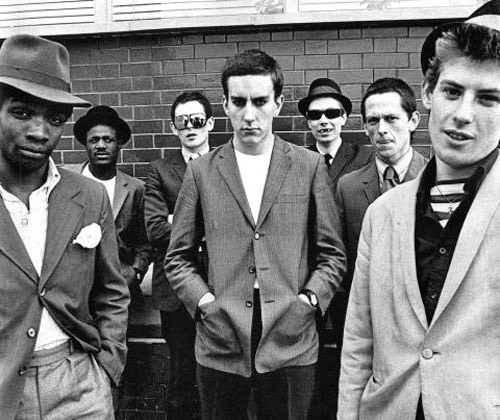Ina 2 Tone Style
Jerry Dammers of the ska revival band The Specials started the short lived but iconic 2 Tone record label in 1979. It spawned a cultural movement, which was popular among skinheads, rudies and some mod revivalists. The label stopped operating in 1986. In the first year of it’s operation, 2 Tone Records signed The Selecter, Madness and The Beat, but they all left within two years. 2 Tone Records acts signed a contract that allowed them to leave the label after releasing just one single, which was unusual in the record industry. Madness and The Beat both took advantage of this clause; the former to sign to Stiff Records, and the latter to start their own label, Go Feet Records.
 The Specials
The Specials
Most of the 2 Tone bands were racially mixed and played a big role in a UK ska revival and the renewed interest in rock steady, blue beat, and roots reggae music in England. Many white band members were products the early punk scene in England which always had a symbiotic relationship with reggae music. When I visited London in 1980, I was amazed the amount of cultural overlap between the post punk movement and the reggae music scene in England.
The reason why 2 Tone became more than just a curious footnote to reggae music history was because the 2 Tone bands delivered the musical goods as live bands and the influence 2nd wave ska revival has remained significant, 30 years after the fact.
I was a skeptic when I first got wind of a ska music revival in England on the post-punk club scene. When I saw the Specials, the Beat, Selector and Madness play live shows in both London and New York I became a believer. Every one of the 2 Tone bands played so well that any question of racial authenticity became a moot point.
 Peter Tosh served as the model for the 2 Tone man
Peter Tosh served as the model for the 2 Tone man
The distinctive Jerry Dammers designed 2 Tone logo portrays a man in a black suit, white shirt, black tie, pork pie hat, white socks and black loafers. The fictional character was based on a photograph of Peter Tosh, during his rude boy days with the early Wailers.
2 Tone had two good years as a social movement and nearly all the first wave revival bands broke up by 1983, but the ska music refuses to die.
 The Beat (known in the USA as the "English" Beat).
Whine & Grind/Stand Down Margaret - The Beat
The Beat (known in the USA as the "English" Beat).
Whine & Grind/Stand Down Margaret - The Beat The twin towers of the Beat were toaster Ranking Roger and Saxa. Ranking Roger was a nimble and imaginative black toaster in the JA style who came up through the punk club scene and Saxa was a 50 year old veteran of the Jamaican ska scene who played with both the Desmond Dekker band and Prince Buster. The multiracial band carved a distinct sound through the use of alternating lead vocals by guitarist Dave Wakeling and Ranking Roger, supported by a tight band consisting of Andy Cox (guitar), David Steele (bass), and Everett Moreton (drums). The Beat was an awesome live band at the time of their debut album but Saxa departed due to the Beat's rigorous touring schedule.
I Just Can't Stop It was the most musically accomplished album of the ska revival and over 30 years later the album remains a timeless masterpiece of punky reggae.
Stand Down Margaret is the Beat's acerbic condemnation of the right wing policies of British prime minister Margaret Thatcher.
 The Beat logo
The Beat logo
__________________________
 Pauline Black & the Selecter
Too Much Pressure - The Selecter
Pauline Black & the Selecter
Too Much Pressure - The Selecter- The Selecter didn't achieve as much notoriety as other 2 Tone bands during ska revival of the early '80s. The Selecter recorded one of the finest albums of 2nd wave ska revival and deserved better than they got. The Selecter's biggest musical asset was lead singer Pauline Black, arguably the best lead singer of the ska revival. The members of the Selecter hailed from Coventry which was also the home of the Specials. Selecter is the Jamaican term for the sound system deejay who selects the records played by a sound system at a dancehall event.
____________________________
 Madness hails from the Camden section of London
One Step Beyond -Madness
Madness hails from the Camden section of London
One Step Beyond -Madness The Madness recording of One Step Beyond takes the Prince Buster ska classic one step beyond the musical anarchy of the Prince's original. As it turns out, Madness has been a huge influence on 3rd wave ska bands.
Madness reinvented themselves as a conventional rock band and had a fair amount of success in the USA, later in the decade. The best songs of Madness contained a great deal witty commentary on British working class life like the Kinks, Squeeze and XTC.
___________________________
Monkey Man- The Specials Without Jerry Dammers and the Specials there would have never been a 2 Tone Records nor a 2nd wave ska revival in the UK. Their live shows were frenetic and anarchic, often ending with the half the audience dancing on the stage with the band.
The Dammers-designed logos, based in '60s pop art with black and white checks, gave the label an instantly identifiable look. Dammers' eye for detail and authenticity also led to the band adopting '60s-period rude-boy outfits (porkpie hats, tonic and mohair suits, and loafers). This cover of the Maytal's Monkey Man first appeared on their Elvis Costello produced debut album.
Embeded below is a killer performance of
Monkey Man at the 2009 Glastonbury Music Festival. It's a bit eerie... Jerry Dammers looks as if he's hardly aged since 1979.
_________________